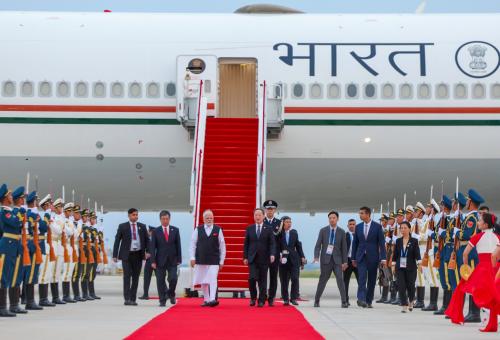During the December 2022 U.S.-Africa Leaders Summit in Washington, D.C., President Joe Biden promised to travel to Africa in the coming year. Few envisioned that it would take 24 months to fulfill this commitment, now likely to occur in early December with a two-day visit to Angola, weeks before the end to his storied political career.
One would be forgiven for asking if the visit is too little, too late. That would be a mistake, however. The visit will deepen the U.S. relationship with Angola, an increasingly important partner for the U.S. in Africa. Biden’s visit will also highlight the Lobito Corridor initiative, an innovative and potentially impactful undertaking by the U.S., the European Union, the governments of Angola, Zambia, and the Democratic Republic of the Congo (DRC) as well as other key stakeholders in the region.
Overcoming the past
There are not many countries in Africa with whom the U.S. has had a more complex relationship than Angola. For 15 years following the country’s independence in 1975, the U.S. was aligned with South Africa’s apartheid government in backing the Union for the Total Independence of Angola (UNITA) rebel movement to overthrow the government of the People’s Movement for the Liberation of Angola (MPLA). The MPLA was supported by the Soviet Union and Cuba in what was one of the most lethal conflicts of the Cold War era.1
By the time of Angola’s first multi-party elections in 1992, hundreds of thousands of lives had been lost and much of the country’s infrastructure had been destroyed. Only in 1993 did the United States formally recognize the government of Angola. The country’s 27-year civil war ended in 2002. During this period, successive American administrations maintained a working relationship with the country’s president, José Eduardo dos Santos. His checkered legacy included 38 years in power, leading a government that was staggeringly corrupt and one that accrued $45 billion in loans from China.
Relations begin to change
In 2017, the diplomatic relationship between the U.S. and Angola took a major step forward when current President João Lourenço, then serving as Angola’s Defense Minister, visited Washington, D.C. to sign a memorandum of understanding with U.S. Secretary of Defense Jim Mattis. The two officials characterized the signing as a precursor to a strategic partnership.
President Lourenço’s initiative was especially bold for a country that had spent decades aligned with Moscow, had a Marxist government until the end of the Cold War, and more recently had been singularly reliant on China for the financing of its infrastructure needs. His diplomacy was reciprocated by visits to Luanda from Defense Secretary Lloyd Austin in September 2023 and Secretary of State Antony Blinken in September 2024. This relationship-building led to a meeting in the Oval Office last November between President Biden and President Lourenço.
The Lobito Corridor initiative
One of President Biden’s early initiatives was the launch of the Partnership for Global Infrastructure and Investment (PGII) at the G7 Summit in Germany in 2022. A key PGII goal was to narrow the investment gap for quality infrastructure. Unstated was the intention among the G7 members to provide an alternative to China’s Belt and Road Initiative.
At the G7 summit in Japan a year later, the Biden administration announced the Lobito Corridor initiative as part of PGII. The undertaking is intended to expand and modernize the transportation corridor connecting the DRC and Zambia with global markets through the port of Lobito, Angola. The ultimate vision is to create an open-access rail line from the Atlantic Ocean to the Indian Ocean.
In October 2023, seven parties convened in Brussels to sign a memorandum of understanding to develop the Lobito Corridor and a new Zambia-Lobito rail line. The signatories include the African Development Bank and the African Finance Corporation, along with the governments of Angola, the DRC, Zambia, the United States, and the European Union. The Development Bank of Southern Africa has also invested in the project and other regional banks are considering doing the same.
In a region where the U.S. was expelled from its military base in Niger and has been unable to negotiate an end to the conflict in Sudan, which is facing a humanitarian crisis of unprecedented proportions, the Lobito Corridor initiative could bolster the standing of the U.S.in Africa for several reasons.
For one, the initiative is a unique collaboration between the U.S., the EU, African governments, and African financial institutions to develop a vital infrastructure project. If successful, it could become a blueprint for future multilateral engagements on the continent.
Second, with over $3 billion already mobilized, the project is the largest ever rail investment in Africa by the U.S. It is also designed to spur development in other sectors along the corridor, such as agribusiness, roads, water systems, and digital infrastructure. In addition, the initiative is responsive to Africa’s infrastructure financing gap, estimated to be as high as $100 billion annually.
Finally, the Lobito Corridor is the quickest and most efficient route for exporting critical minerals from the central African copper belt on to the U.S. and Europe. Enhancing access to critical minerals is a bipartisan issue in the U.S. Congress which could lead to continued support for the project in an otherwise divided U.S. Congress.
The prospect for US-Angolan commercial relations
Angola’s oil sector accounts for more than 90% of its exports and over 70% of government revenue. Given this concentration, the country “urgently” needs to diversify its economy and remove barriers to private investment, as highlighted by the World Bank.
The U.S. is well-positioned to support the government’s efforts in this respect. Until now, the American business presence has been dominated by U.S. oil companies. In fact, Chevron is celebrating 70 years of doing business in Angola. More recently, however, U.S. investments in Angola have included the construction of over 180 rural bridges which enable crops to get to market, upgrading 4G and 5G digital connectivity across the nation, and bringing 500 megawatts of solar power to the grid.
As a result of these investments, the U.S. is reinforcing Angola’s goals to generate 70% of its energy from renewable sources by 2025 and to become food self-sufficient by 2027. Commercial ties are likely to deepen further when Angola hosts the U.S.-Africa Business Summit next year, which coincides with the country’s 50th anniversary of its independence.
These initiatives, especially the Lobito Corridor initiative, reflect the White House strategy toward sub-Saharan Africa that seeks to develop a deeper bench of partners and more flexible regional architecture. In Angola, President Biden will have the opportunity to highlight the progress his administration has had in implementing this strategy which, hopefully, will be embraced by his successor in the White House.
-
Footnotes
- Witney W. Schneidman, Engaging Africa: Washington and the Fall of Portugal’s Colonial Empire (2004: University Press of America) pp. 208-223.
The Brookings Institution is committed to quality, independence, and impact.
We are supported by a diverse array of funders. In line with our values and policies, each Brookings publication represents the sole views of its author(s).








Commentary
Why Biden’s visit to Angola matters
November 1, 2024